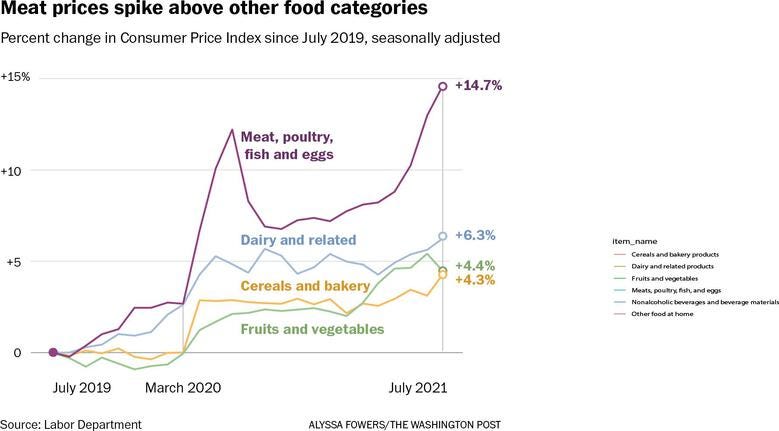Winter is Coming
Help Americans offset high food, housing, and heating bills this winter with unused local funds from the American Rescue Plan.
As President Biden and congressional Democrats haggle over the final stages of their infrastructure and social spending packages, a serious new threat looms on the horizon for many hard-pressed American families: high food, housing, and energy costs.
Rather than allow another set of economic challenges to overwhelm the country—and further dent Democrats’ already wobbly standing with the public—the Biden team and localities could do something immediately useful for people by repurposing uncommitted funds from the American Rescue Plan (ARP) to help Americans handle these high bills over the upcoming winter.
Food, housing, and energy costs are up.
There’s no denying the hit to family budgets over the past few months from rising prices on important household items including food, rent, gasoline, heating oil, and natural gas. Labor Department data through first part of the summer show a significant spike in the prices of nearly all food categories with meat, poultry, fish, and eggs up the most—14.7 percent since 2019 before the pandemic.
Housing data also show a sharp rise in median apartment rents so far this year, again outpacing pre-pandemic trends significantly, according to Apartment List’s national data trends.
And, as The Wall Street Journal recently highlighted, energy costs are “soaring” particularly high for all American consumers, potentially threatening future economic prospects:
Crude oil has risen 64% this year to a seven-year high. Natural-gas prices have roughly doubled over the past six months to a seven-year high. Heating oil has risen 68% this year. Prices at the pump are up nearly a dollar over the past 12 months to a national average just over $3 a gallon. Coal prices are at records.
Higher energy prices could push up inflation in coming months, damp consumer spending on other products and services, and ultimately slow the U.S. recovery, economists say.
The expected length and severity of these higher costs has not been definitively laid out, but many economists predict they will last through the first half of 2022 or longer. This means continued economic pain for millions of Americans, even with wages rising in many places and the economy doing well in the aggregate.
Fortunately, there may be some existing ways to help people get through these tough times.
Localities have a lot of unused ARP funds.
As the Brookings Metropolitan Policy Program shows, the American Rescue Plan passed earlier this year included a substantial infusion of cash—$130 billion to be exact—for cities, counties, and tribes to use in flexible ways to address a host of economic and budgetary needs. A lot of this money has not been dedicated to any specific purpose.
According to tracking by Alan Berube and Eli Byerly-Duke at Brookings, highlighted in the chart below, 20 cities with reported data through July on ARP expenditures have yet to commit roughly 80 percent of these first round funds sent from the federal government.
As the analysts argue, a small chunk of these funds have already been designated to help low-income communities, which could be expanded to include other areas:
A number of cities are planning to use—or already have used—significant funds to address challenges facing low-income and other disproportionately impacted communities. The interim Treasury rule provides local governments with fairly wide latitude in this area. St. Louis, for instance, has committed nearly $72 million (about 16% of its total allocation) to helping such communities, including shelter and services for the homeless, funds to prevent eviction, and programs for young people. Boston, Minneapolis, and Seattle also plan to dedicate significant FRF dollars to address affordable housing needs and combat homelessness. In Buffalo, investment in city parks—especially in low-income neighborhoods and for child-related amenities—represents one of the largest planned expenditures. Services to disproportionately impacted communities account for 21% of the $1.3 billion the 20 cities have thus far committed. Some cities that have announced plans not yet reflected in official reports—such as Detroit, Pittsburgh, St. Paul, Minn., and Austin, Texas—are poised to make large commitments in this area too.
Although the next round of city and county plans for these funds are due at the end of the month, localities still have time to make good use of this one-time cash infusion to directly assist low-to-moderate income households facing rising costs.
Current guidelines allow these funds to be used for “spending tied to the public health emergency from COVID-19 or its negative economic impacts,” according to analysis from Amanda Kass. So let’s put them to use.
Solution: Repurpose ARP funds to help people get through the winter.
President Biden and Democrats desperately need some wins politically. Passing the bi-partisan infrastructure bill and a sensible package of health care, child care, and clean energy plans would obviously help.
But in the meantime, winter is coming, and Biden and local leaders can do something now to directly help many Americans: use existing ARP monies to help people afford basic living needs over the next few months.









